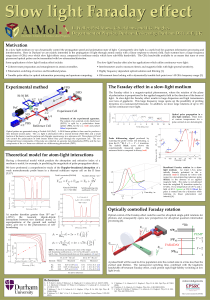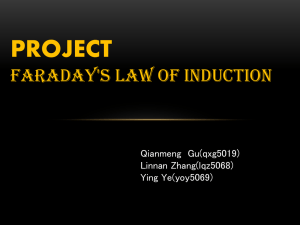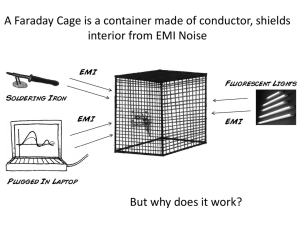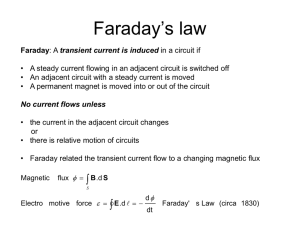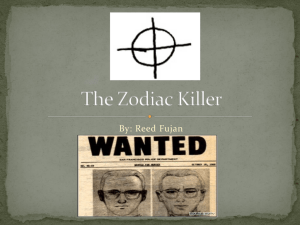The slowlight effect
advertisement
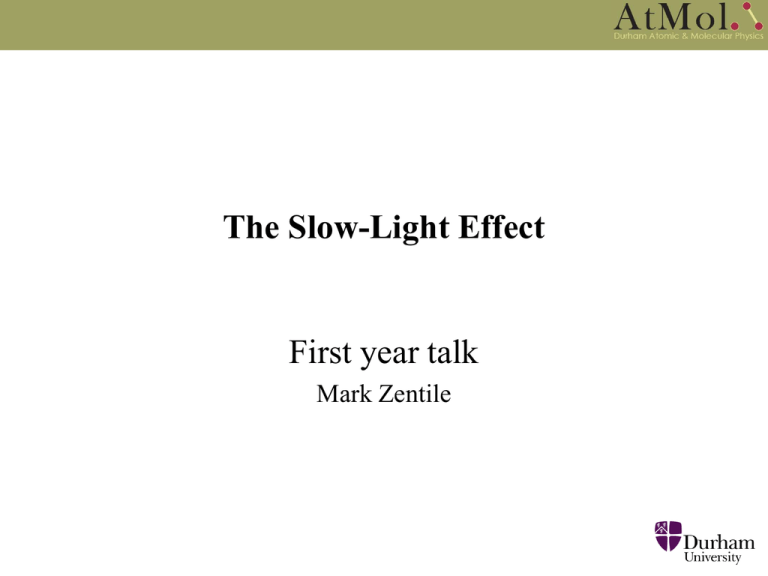
The Slow-Light Effect First year talk Mark Zentile Project Members Lee Weller 08/04/2015 Charles Adams 1st year talk, Mark Zentile Ifan Hughes Outline • Slow-light: – What is slow-light? What conditions are needed to see it? What are the applications? – Phase shift and absorption from the electric susceptibility. – Transmission spectra to extract key parameters for the model. – Using the our model for the electric susceptibility with Fourier analysis to model pulse propagation. – Experimental method and examples of data with theoretical predictions. 08/04/2015 1st year talk Mark Zentile Outline • Future outlook: – Introduce the Faraday effect. – Use a Faraday signal to make a tuneable laser lock over ± 20 GHz detuning. – Harness the slow-light Faraday effect to make an optical switch. 08/04/2015 1st year talk Mark Zentile What is ‘Slow-Light’? 08/04/2015 1st year talk Mark Zentile What is ‘Slow-Light’? 08/04/2015 1st year talk Mark Zentile Slow-light with EIT 08/04/2015 1st year talk Mark Zentile Better interferometers 08/04/2015 1st year talk Mark Zentile Image rotation Image coding 08/04/2015 1st year talk Mark Zentile Optical Delay Line 08/04/2015 1st year talk Mark Zentile Optical Switch 08/04/2015 1st year talk Mark Zentile Outline • Slow-light: – What is slow-light? What conditions are needed to see it? What are the applications? – Phase shift and absorption from the electric susceptibility. – Transmission spectra to extract key parameters for the model. – Using the our model for the electric susceptibility with Fourier analysis to model pulse propagation. – Experimental method and examples of data with theoretical predictions. 08/04/2015 1st year talk Mark Zentile Complex refractive index ABSORPTION 08/04/2015 DISPERSION 1st year talk Mark Zentile Transmission Spectra 08/04/2015 1st year talk Mark Zentile The model for the electric susceptibility • Our model has been developed over many years: Result of solving the optical Bloch equations for a two level atom. • Accurate up to ~ 120oC • Includes: absolute linestrengths Doppler broadening Temperature dependent number density. Siddons et al. J. Phys. B: At. Mol. Opt. Phys. 41 (2008) 155004 08/04/2015 1st year talk Mark Zentile The model for the electric susceptibility • Inclusion of self-broadening: • Accurate up to ~ 360oC • Includes: absolute linestrengths Doppler broadening Temperature dependent number density. Self-broadening for binary-collision approximation Weller et al. J. Phys. B: At. Mol. Opt. Phys. 44 (2011) 195006 08/04/2015 1st year talk Mark Zentile The model for the electric susceptibility • Inclusion of magnetic field: • Tested up to 0.6 T • Includes: absolute linestrengths Doppler broadening Temperature dependent number density. Self-broadening for binary-collision approximation Magnetic energy level shift. Weller et al. J. Phys. B: At. Mol. Opt. Phys. 45 (2012) 055001 08/04/2015 1st year talk Mark Zentile Outline • Slow-light: – What is slow-light? What conditions are needed to see it? What are the applications? – Phase shift and absorption from the electric susceptibility. – Transmission spectra to extract key parameters for the model. – Using the our model for the electric susceptibility with Fourier analysis to model pulse propagation. – Experimental method and examples of data with theoretical predictions. 08/04/2015 1st year talk Mark Zentile Transmission: Extracting parameters • We want to use transmission spectra to measure experimental parameters. – Transmission χ(ω) dispersion slow-light theory. • Why model transmission spectra? Can’t we just use Kramers-Kronig? – Yes, but... 08/04/2015 1st year talk Mark Zentile Transmission: Extracting parameters • Rubidium 75 mm long cell, room temperature. Excellent agreement. One fit parameter: Temp = (20.70 ± 0.13) oC 08/04/2015 1st year talk Mark Zentile Transmission: Extracting parameters • 2 mm long 98.2% 87Rb cell: 3 fit parameters: Temp = (90.2 ± 0.1)oC Lorentzian FWHM = 2π ∙ (165 ± 1) MHz Very large! => Buffer gas. Ratio of 87Rb to 85Rb = 0.982 ± 0.009 08/04/2015 1st year talk Mark Zentile Transmission: Extracting parameters • 2 mm long 87Rb cell (high temp): 2 fit parameters: Temp = (182.1 ± 0.4)oC Lorentzian FWHM = 2π ∙ (170 ± 4) MHz Very large! => Buffer gas. 08/04/2015 1st year talk Mark Zentile Outline • Slow-light: – What is slow-light? What conditions are needed to see it? What are the applications? – Phase shift and absorption from the electric susceptibility. – Transmission spectra to extract key parameters for the model. – Using the our model for the electric susceptibility with Fourier analysis to model pulse propagation. – Experimental method and examples of data with theoretical predictions. 08/04/2015 1st year talk Mark Zentile Fourier Method for pulse propagation • Electric susceptibility model is designed for monochromatic continuous wave light. • Pulses are clearly not monochromatic continuous wave light! • Solution: Use a Fourier transform to write the pulse in terms of continuous wave light. 08/04/2015 1st year talk Mark Zentile Fourier Method for pulse propagation • Fourier decomposition: 08/04/2015 1st year talk Mark Zentile Good conditions for slow-light? Rubidium at natural abundance 08/04/2015 1st year talk Mark Zentile 98.2% 87Rb Fast-Light 08/04/2015 1st year talk Mark Zentile Outline • Slow-light: – What is slow-light? What conditions are needed to see it? What are the applications? – Phase shift and absorption from the electric susceptibility. – Transmission spectra to extract key parameters for the model. – Using the our model for the electric susceptibility with Fourier analysis to model pulse propagation. – Experimental method and examples of data with theoretical predictions. 08/04/2015 1st year talk Mark Zentile Experimental Setup 08/04/2015 1st year talk Mark Zentile Advantages/disadvantages of FPD • Works over one shot • Slow rise time => poor resolution • Need relatively intense pulses => may not be weak probe. 08/04/2015 1st year talk Mark Zentile Picture from http://www.eotech.com/product/14/ 2GHz_Amplified/ Advantages/disadvantages of SPCM • Slightly better timing resolution. • Works for much less Intense pulses. • Must build a pulse profile over many repetitions. Picture from http://excelitas.com/downloads/ DTS_SPCM_AQRH.pdf 08/04/2015 1st year talk Mark Zentile Preliminary experimental data (FPD) Group refractive index of ~1000 08/04/2015 1st year talk Mark Zentile Experimental data with theory (FPD) Reference • 87Rb cell. •Laser locked by polarization spectroscopy. • Carrier frequency on resonant with 85Rb D1 Fg=2 Fe=2,3 transition frequency. Pink = Measured output Red Dashed = Theory 08/04/2015 1st year talk Mark Zentile Experimental data with theory (SPCM) Reference • Rb natural abundance cell. •Counted over a relatively short time Red = Measured output Black Dashed = Theory 08/04/2015 1st year talk Mark Zentile Outline • Future outlook: – Introduce the Faraday effect. – Use a Faraday signal to make a tuneable laser lock over ± 20 GHz detuning. – Harness the slow-light Faraday effect to make an optical switch. 08/04/2015 1st year talk Mark Zentile The Faraday Effect • Linearly polarized light can be constructed from a circularly polarized basis. 08/04/2015 1st year talk Mark Zentile The Faraday Effect • A magnetic field breaks the degeneracy for right and left circular components 08/04/2015 1st year talk Mark Zentile The Faraday Effect • Have already seen that the model can accurately predict Faraday rotation: Weller et al. J. Phys. B: At. Mol. Opt. Phys. 45 (2012) 055001 08/04/2015 1st year talk Mark Zentile A Faraday signal as a laser lock • Take inspiration from this paper. Locking offresonance Marchant, A. L., Händel, S., Wiles, T. P., Hopkins, S. A., Adams, C. S., & Cornish, S. L. (2011). Optics letters, 36, 64-6. 08/04/2015 1st year talk Mark Zentile A Faraday signal as a laser lock • Can use our 1 mm long cell placed in a permanent magnet to achieve high magnetic fields • We will be able to lock on-resonance as well as off. 08/04/2015 1st year talk Mark Zentile Outline • Future outlook: – Introduce the Faraday effect. – Use a Faraday signal to make a tuneable laser lock over ± 20 GHz detuning. – Harness the slow-light Faraday effect to make an optical switch. 08/04/2015 1st year talk Mark Zentile The Slow-light Faraday effect Large rotation with little absorption Siddons, P., Bell, N., Cai, Y., Adams, C. S., & Hughes, I. G. (2009). Nature Photonics, 3, 225 08/04/2015 1st year talk Mark Zentile Use optical pumping to control rotation • Can also cause a rotation by having an unbalanced distribution in the populations of the Zeeman sub-levels. 08/04/2015 1st year talk Mark Zentile Use optical pumping to control rotation 08/04/2015 1st year talk Mark Zentile Summary – Seen what slow-light is and what its applications are. – Phase shift and absorption from the electric susceptibility. – How we use transmission spectra to measure parameters for the model. – Seen how to model pulse propagation with the Fourier analysis, once χ in known. – Experimental method and examples of data with theoretical predictions. 08/04/2015 1st year talk Mark Zentile Summary – Explained the Faraday effect. – Want to use a Faraday signal to make a tuneable laser lock. – Harness the slow-light Faraday effect to make an optical switch. 08/04/2015 1st year talk Mark Zentile End Thanks for listening. 08/04/2015 1st year talk Mark Zentile Fit with magnetic field 08/04/2015 1st year talk Mark Zentile Controlled Faraday rotation Siddons, P., Adams, C. S., & Hughes, I. G. (2010). Physical Review A, 81, 043838 08/04/2015 1st year talk Mark Zentile Pump-Probe energy level diagram 08/04/2015 1st year talk Mark Zentile Jitter in arrival time • FPD shows a ‘jitter’ in the arrival time and peak height. • This will broaden a photon counted pulse! 08/04/2015 1st year talk Mark Zentile Simulating photon counting pulses 08/04/2015 1st year talk Mark Zentile
